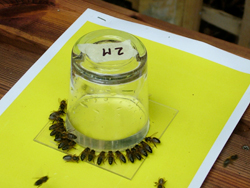Final-Year Experimental Project (BES, C1126, autumn and spring terms)
Professor Ratnieks supervises projects on the behaviour of honey bees and ants. These projects enable students to work with live animals and to do a real research project that addresses a cutting-edge question. Projects generally investigate a specific, focused question or hypothesis. Students interested in doing a final-year project on social insects can make informal enquiries to Professor Ratnieks any time. Students who want to do a social insect project with Professor Ratnieks should have a keen interest in animal behaviour/behavioural ecology, should take the third-year course in Social Insects, and ideally should have taken the second-year course in Behavioural Ecology. Projects can be started either in the summer vacation or at the start of the autumn term. Students doing a honey bee project may well receive a few stings. Students doing an ant project are less likely to be stung by honey bees but it may happen. As a result, projects at the Laboratory of Apiculture and Social Insects are not suitable for students who are allergic to bees or who are fearful of bees.
In 2008/09 the projects were on the topics below:
 Students Heather Moore and Nicola Firmin doing their experiment on flower constancy in honey bees
Students Heather Moore and Nicola Firmin doing their experiment on flower constancy in honey bees
Flower constancy in honey bees
How does the volume or concentration of nectar reward influence the constancy of worker bees to that particular colour of flower?
Nestmate recognition in honey bees
Do honey bee alarm pheromones cause guard bees to reduce their acceptance threshold?
Colony organisation in ants
How does the geometry of the trail system of a Pharaoh's ant colony affect the tendency of workers to make U-turns or to chose a branch at a trail bifurcation.
Projects for 2009/10 and future years
In addition to the projects listed below, other projects may be possible following discussion with Professor Ratnieks. Students from other departments who may want to do a project involving social insects should also contact Professor Ratnieks to discuss the possibilities.
1. Nestmate recognition and guarding in honey bees
Type: experiment.
Details: research project working with guard bees at the entrances of bee hives to investigate mechanisms of nestmate recognition and adaptive responses of guards to intruders. The project will investigate a specific, focused question/hypothesis within this. Field work is done in autumn (October and November) when it is still warm enough for the bees to be active, in the apiary of the Laboratory of Apiculture and Social Insects which is 50m from the John Maynard Smith Building.
 Experiment investigating flower colour learning and the effect of nectar reward on this
Experiment investigating flower colour learning and the effect of nectar reward on this
2. Acquisition of flower constancy in foraging honey bees
Type: experiment.
Details: the project will investigate a specific, focused question/hypothesis within this. Field work is done in autumn (October and November) when it is still warm enough for the bees to be active, in the apiary of the Laboratory of Apiculture and Social Insects which is 50m from the John Maynard Smith Building.
3. Decoding honey bee dances to investigate honey bee foraging
Type: experiment.
Details: research project working with honey bees in which students decode waggle dances to determine where in the landscape bees are foraging. The project will investigate a specific, focused question/hypothesis within this. Field work is done in autumn (October and November) when it is still warm enough for the bees to be active, in the Laboratory of Apiculture and Social Insects which is 50m from the John Maynard Smith Building. In addition, waggle dances will be videotaped so that dances collected in the summer and autumn can be compared.
4. Organisation and communication in foraging ants
Type: experiment.
Details: research project working with ants (either the common garden ant Lasius niger or the Pharaoh's ant Monomorium pharaonis) in which students investigate a specific, focused question/hypothesis in foraging behaviour. This will investigate some aspect of communication or learning as it relates to the organisation of the foraging trail system. Colonies will be studied indoors at the Laboratory of Apiculture and Social Insects which is 50m from the John Maynard Smith Building.


